By Peter M. DeLorenzo
Detroit. As longtime readers well know, the Chevrolet Corvette has played an inexorable role in my ongoing car addiction. I’ve been honored to have experienced some of the most famous and spectacular Corvettes ever built in period and in real time. Those experiences are forever etched in my mind, and for reasons I’ll explain later, I think it’s high time I give you a glimpse into Corvette history, because for me, it never gets old.
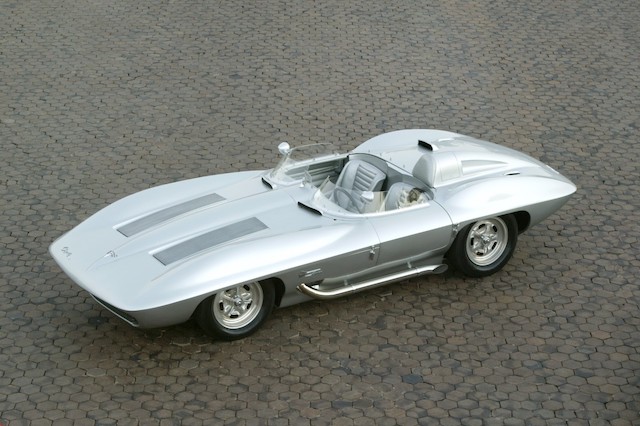
(GM)
The 1959 Corvette Sting Ray racer photographed at the GM Styling viewing courtyard in 1960.
The 1959 Corvette Sting Ray racer. As I’ve stated many, many times in these pages, this machine is my all-time favorite car. I first saw it one blistering summer afternoon in our neighborhood in 1962, and I will never forget that day. I was still in my bike-riding days back then, but I remember resting with my buddies on a corner in our neighborhood after a long, hot day of riding around aimlessly – we did that often back then – when we heard a rumble and roar coming from off in the distance. I knew right away that it wasn’t motorcycles and that it was more than one of whatever it was – and just then a pack of the most stunning cars we’d ever seen burst around the corner and came rumbling right past us – the sun glinting off the barking pipes and the canopy of trees shimmering off the perfect mirror finishes of the paint jobs. This “horsepower train” was led by the 1959 Corvette Sting Ray racer in Silver, followed by the XP700 Corvette (a “bubble-top” show car with side pipes also in Silver – it was Mitchell’s favorite color), the first Mako Shark Corvette and a concept called the Corvair Super Spyder (also in Silver), a wild, racing-inspired show car with dual cut-down racing windscreens and three pipes curling out and around each side in the back.
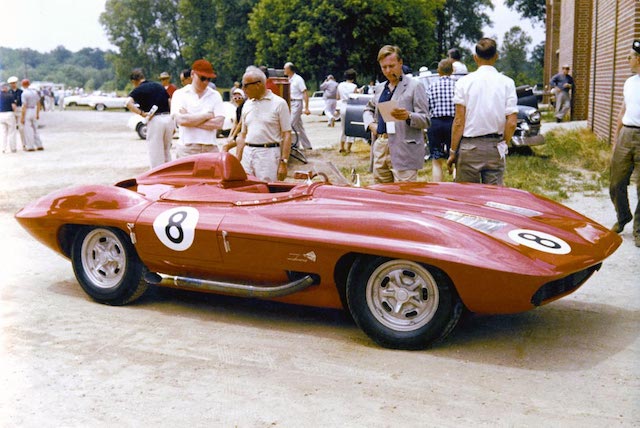
(GM)
A rare photo of the Corvette Sting Ray racer in its original red livery, taken at Elkhart Lake, Wisconsin, in 1959.
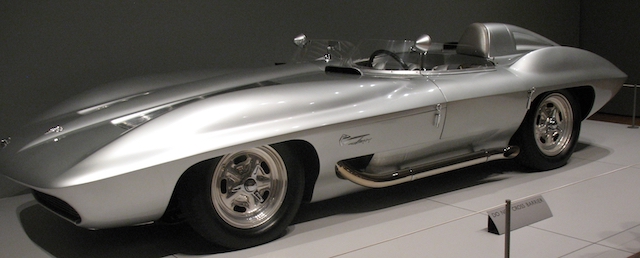
(GM)
The Corvette Sting Ray racer as it appears today.
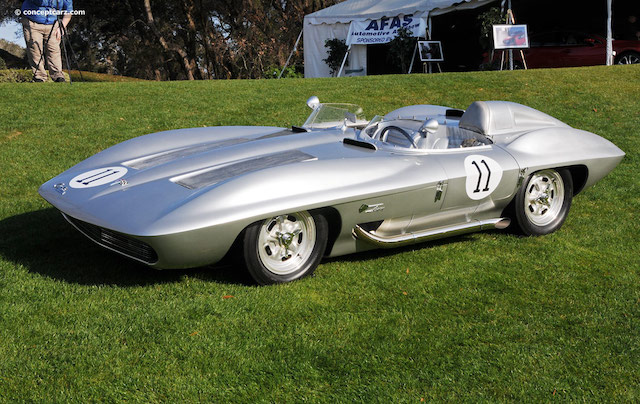
(conceptcarz.com)
The Corvette Sting Ray racer “live” at a car show.
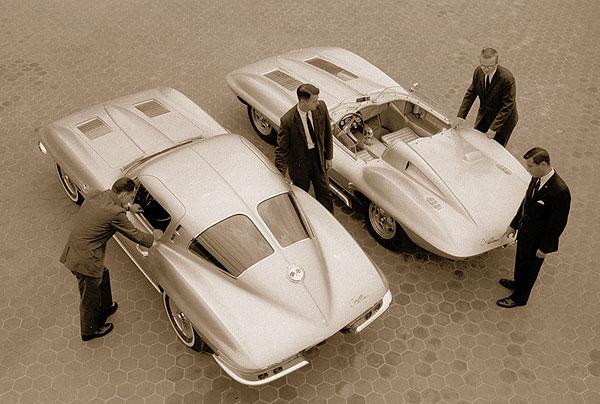
(GM)
The 1959 Corvette Sting Ray racer and the 1963 Corvette Sting Ray production car photographed at the GM Styling viewing courtyard in the fall of 1962.
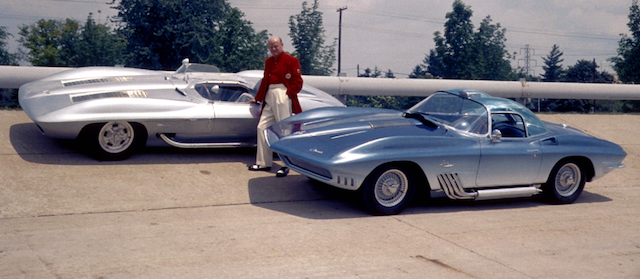
(GM)
Bill Mitchell photographed with the 1959 Corvette Sting Ray racer and the 1961 Corvette Mako Shark at the test track, GM Technical Center, 1961.
They were so loud we couldn’t even hear ourselves screaming whatever it was we were screaming, but after a split second to think about it we took off, pedaling our guts out after them. It was apparent that these machines were heading for our part of the neighborhood – and as we tried to keep them in sight, I realized they were turning on to my cross street…
We came around the corner and saw them pull into a driveway, exactly one block from my house. We stopped right at the end of the driveway with our mouths gaping down to the asphalt, as the drivers of the other cars handed the keys to the driver of the Sting Ray and he took them up to the front door where a woman collected them. Then, an Impala pulled up and the four men got in it and were gone, leaving the cars sitting in the driveway all lined up ticking and spitting as their pipes started to cool. This became the Friday afternoon ritual in the summer, because that’s the way Bill Mitchell wanted it. GM’s legendary design chief liked having a selection of his toys to play with on the weekends, and I was lucky enough to live just a block away from him.
All of those cars were special, but the ’59 Sting Ray racer was by far my favorite the moment I laid eyes on it. If you’ve ever had the pleasure of seeing the original Sting Ray racer in person, it is a stunning machine. (Although for those who haven’t, you might not be prepared for how compact it is.)
Its taut, beautifully rendered lines absolutely glow in Mitchell’s favorite color – German racing “silver arrow” metallic – and as I said, to this day it remains my all-time favorite car. A favorite story? When Ed Welburn took over the reins of GM Design many years ago, the first thing he did was order the restoration of the ’59 Sting Racer, which had fallen into neglect and in desperate need of rejuvenation. And the GM artisans did a phenomenal job bringing it back to its previous glory. But the one area they didn’t touch? The seats, because Ed wanted them to remain in their original condition, in honor of all of the famous people who sat in them. An exquisite touch, and it remains the jewel of GM’s collection of historic vehicles.
No, I don’t count myself as one of those famous people, but I did have the honor of riding shotgun in the ’59 Sting Ray racer several times with Bill Mitchell at the wheel. The memory remains as technicolor vibrant as if it happened yesterday.
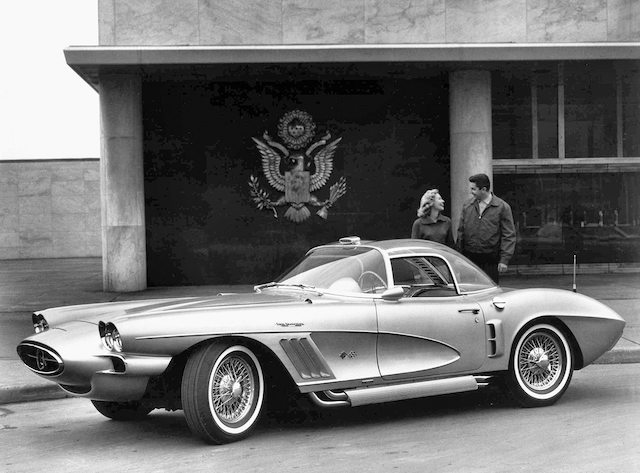
(GM)
The wild 1958 Corvette XP-700 concept from GM Styling.
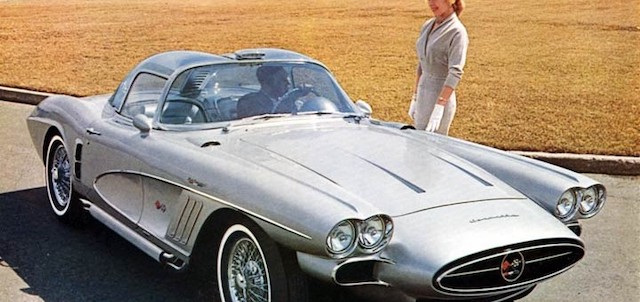
(GM)
Another angle of the Corvette XP-700.
1958 Corvette XP-700 concept. This wild Corvette concept was the first car I rode in with Bill Mitchell at the wheel. Some may not like the looks of this beast, but it was surprisingly alluring in person. The one thing I can report is that its “bubble” top – which was an infatuation of Mitchell’s at the time – redefined the concept of “solar gain” as it baked your brains out in the summer sun. And that was fine with me, because to ride around in that cool, futuristic machine was a treat beyond words. The XP-700 eventually disappeared. Why? It became the underpinnings of the next car…
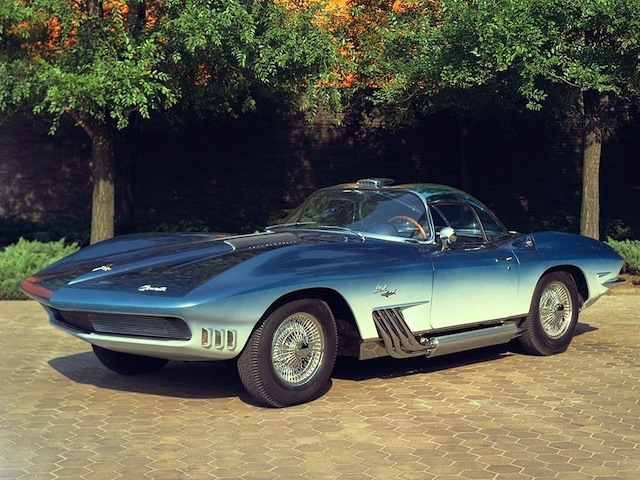
(GM)
The 1961 Corvette Mako Shark I.
1961 Corvette Mako Shark. The Mako Shark concept (XP-755) was another thing altogether. This machine bristled with remarkable details, like the “gills” that doubled as sequential turn signals, the glorious side pipes and, of course its bubble top. But the most remarkable characteristic was its fantastic paint job, which mimicked the gradations of a Mako Shark. That paint job was mesmerizing back then and amazing in every sense of that overused word. Today, this machine is in desperate need of a full restoration, but that paint job remains its signature. How did this all come about? One of the countless anecdotes from the Mitchell era was that he caught a Mako shark on a fishing trip in Florida and had it mounted on a wall in his office. He kept telling the designers that he wanted the paint job on the Mako Shark concept to look exactly like the shark on his wall, with the same color gradations. After Mitchell rejected several attempts at painting the XP-755 and amid growing frustration, a few designers sneaked into his office late one night while Mitchell was out of town and removed the shark from his office wall. They then had the paint shop paint Mitchell’s prized catch exactly like the latest version of the paint job on the Mako Shark concept. They then put the shark back up on his wall and presented the new paint job on the Corvette Mako Shark concept to Mitchell, who pronounced it “perfect.”
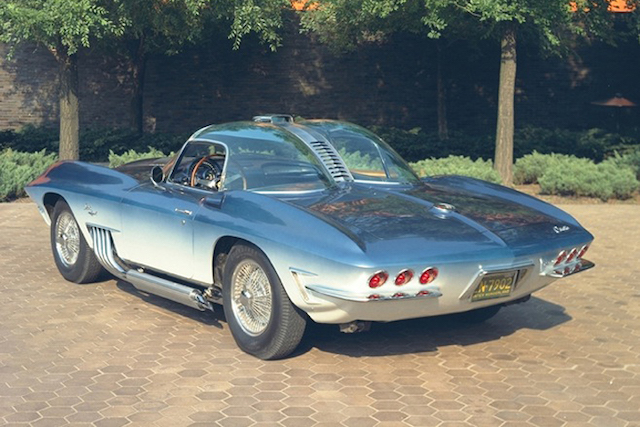
(GM)
The paint job is truly wild – and stunning – on the Mako Shark I.
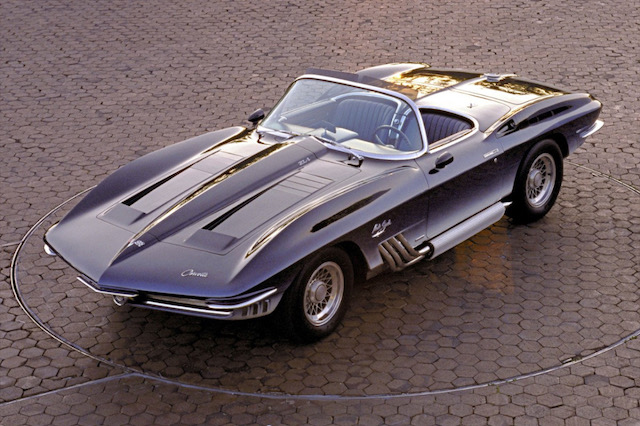
(GM)
The 1961 Corvette Mako Shark I as it appears today.

(GM)
The 1961 Corvette Mako Shark 1 and 1965 Corvette Mako Shark II, photographed at the GM Technical Center in Warren, Michigan, in 1965.
1962 Corvette Convertible. Going by the specs, this GM PR car was nothing special. It was white with a black top and black interior, and it had the 300HP 327 V8 with a four-speed gearbox. Standard fare for a Corvette back then. But it was the Corvette that we “borrowed” almost every weekend, and it was the machine that burnished “Corvette” in our collective consciousness forever.
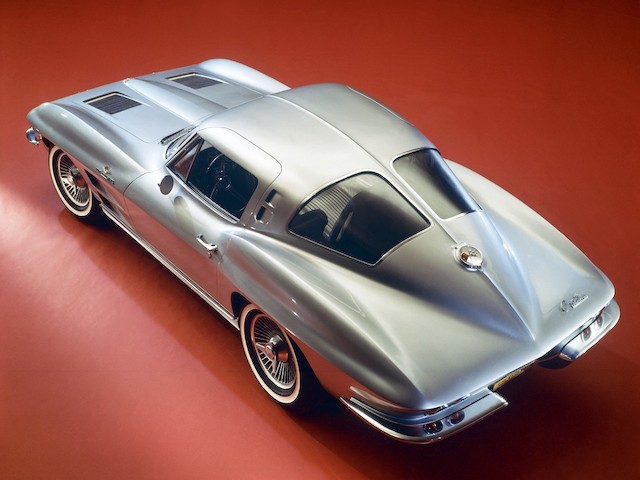
(GM)
The 1963 Corvette Sting Ray remains one of the most iconic automobiles ever built.
Ed Cole’s 1963 Corvette Sting Ray. We got to know Ed (and Mitchell, of course) through our father, who was in charge of GM PR from 1957-1979. Ed took note that my brother Tony and I were totally into cars, so he often would send over cars for my brother to drive. One year he sent over his personal driver, which was a 409-powered Impala with a 4-speed. The only other 409 in existence was in “Dyno” Don Nicholson’s hands at the NHRA finals. Needless to say, we had a blast mopping up everything in sight on Woodward Avenue that weekend. But the most memorable car that Ed sent over was his personal 1963 fuel-injected Corvette Sting Ray coupe in Sebring Silver (with a 4-speed gearbox, of course). The new Sting Ray had been announced, but there were none on the street yet, except for Ed’s company car. To this day, the Sting Ray was one of the most dramatic and memorable auto introductions of all-time, and driving it that weekend was like piloting a rolling space ship. No other car said “The Future” like the first Corvette Sting Ray. It was simply spectacular.
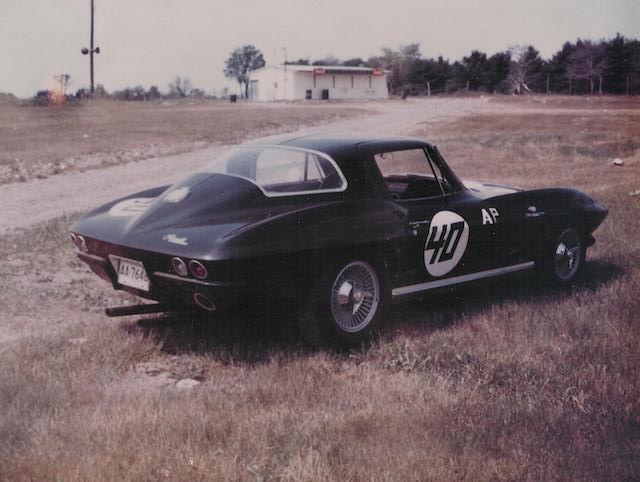
(The DeLorenzo Archives)
Watkins Glen, 1964. The “Zora-ized” Corvette Sting Ray coupe as it appeared for the SCCA Driver’s school that summer. Note the straight pipes out the back.
The 1964 “Zora-ized” Corvette Sting Ray. By early summer of 1964, my brother Tony’s automotive bug started to seriously turn toward sports car racing. He innocently asked “big” Tony if we could order a Corvette company car for the summer, and little did he know that the adventure was just beginning. As my brother said: “He made two errors: 1.) He agreed to do it and 2.) He let us order it!” And order it we did: A Black/Black 1964 Corvette Sting Ray Coupe with Heavy Duty finned drum brakes; Heavy Duty gearbox; knock-off aluminum wheels and radio delete. Little did our father know that Tony planned to take it to SCCA Driver’s School in Watkins Glen, New York. So, the moment we got it we took the interior carpeting out, took the bumpers off, removed the spare tire carrier, and then we had a roll bar put in and we were good to go. Or so we thought. While Tony was sitting at his desk at Chevrolet Sales Promotion (his summer job) a few days later the phone rang. This is how he remembers it:
“Hello?”
“Tony, this is Zora Duntov.” Yikes, it was the God of the Corvette calling. “Your father has ordered a heavy-duty Corvette. Who is going to drive it?”
“Um… He is?!!”
Silence.
“Who is going to drive it?”
“Um, I am.”
“What are you going to do with it?”
“Uhhh… I’m going to go to SCCA driver’s school at Watkins Glen.”
“Ok.”
And “God” hung up. But not before requesting that we drop the car off at Chevrolet Engineering in Warren so he could “take care of a few things.” Two weeks later we went back to get the car, and Zora took Tony out to the little test track that sits inside the Tech Center. And there it was, it was the same Corvette but it sat lower and it was wearing the biggest Goodyear Blue Streak racing tires that could fit inside the fenders on the knock-off wheels. Zora also pointed out that the stock exhaust system underneath now had flanges just in front of the mufflers. Those flanges had been put on by Bill Mitchell’s famous Styling Garage mechanic, Ken Eschebech, so that once we got to Watkins Glen, we could attach 4′ long straight pipes designed to hang on special hangers, so that they would shoot straight out the back. Because, well, you can’t run a Driver’s School at Watkins Glen with standard mufflers, right? Zora was a genius.
But those changes were just the tip of the iceberg. The car had been completely gone through, including the brakes, the suspension and sure enough, the engine. In retrospect, we were convinced that Zora had the engine yanked, gone through and tweaked, because the thing was a rocket.
That trip to Watkins Glen was an adventure unto itself. We arrived very late one night at the rustic Glen Motor Inn, and the one and only Vic Franzese checked us in, but not before he could show us his beautiful Lotus 11. The school went exceptionally well for Tony; at one point the Chief Instructor went to ride a couple of laps with him and emerged muttering something like “he’s doesn’t need any more instruction” – and that was the beginning of his racing life. The return trip was eventful, too, as were so tired by the end of the weekend that we said, “screw it” and left the straight pipes on, rattling hearts and bones all the way back.
There’s more to this story. It was getting toward the end of that summer, when dad informed us that the car had to go back to Chevrolet to be put back into stock condition. It turns out that our oldest sister’s boyfriend at the time, who lived in Chicago, had expressed interest in buying the car. We took the roll bar out, piled the stock components in it and voila! It returned two weeks later as if none of it happened, with dad saying: “When that car comes back to the house, don’t touch it!” We didn’t. The sad end to this chapter? The guy in Chicago had it for two days. On the second night it was stolen, stripped – and totaled.
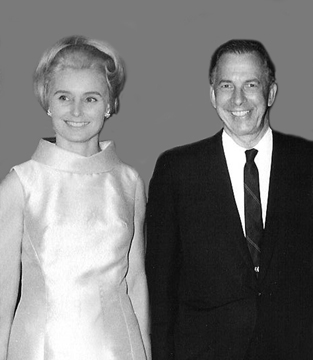
Dollie Cole’s “Bluebird” 1965 Sting Ray convertible. Ed Cole was the brilliant engineering genius and true enthusiast who was one of the creators of the small block Chevrolet V8 and who led GM Product Development in its heyday. Ed is a true icon of the industry. Dollie was his radiant wife, a fierce defender of all things Ed and a fiery enthusiast in her own right. She roared around Bloomfield Hills and Birmingham – two northern suburbs of Detroit – in her ’65 Nassau Blue Corvette roadster with a white interior, a removable hard top, a 4-speed and side pipes. Dollie also had a lead foot and drove the hell out of it. She famously dubbed it her “Bluebird.” Ed stuffed a big-block 396 V8 in it months before the engines were released to the public. She let Tony borrow it on several occasions. It was quick and suitably loud.
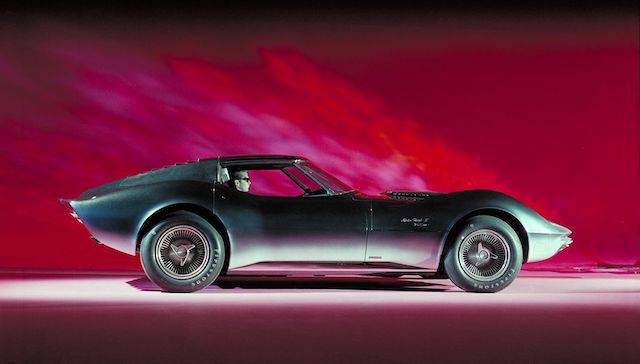
(GM)
The 1965 Corvette Mako Shark II, another stunning machine from GM Styling.
The 1965 Corvette Mako Shark II. What can be said about this machine other than the fact that Bill Mitchell and his handpicked designers turned the dial up past “11” to come up with one of the most iconic Corvette shapes of all time? The obvious successor to the Mako Shark I, the “II” bristled with spectacular details that even today – in its “Manta Ray” guise – resonate mightily.
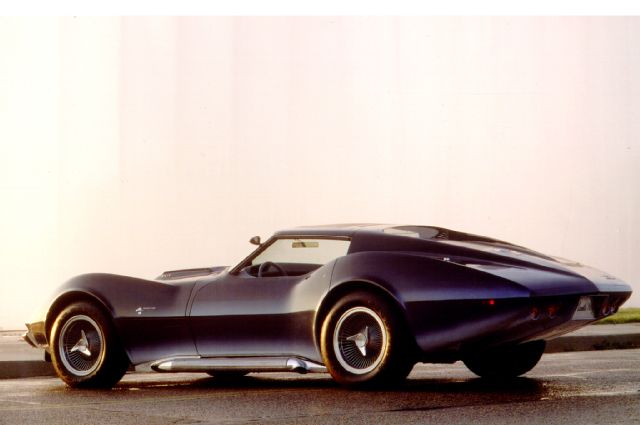
(GM)
The Mako Shark II transformed into the 1969 Corvette Manta Ray, which is how it appears today.
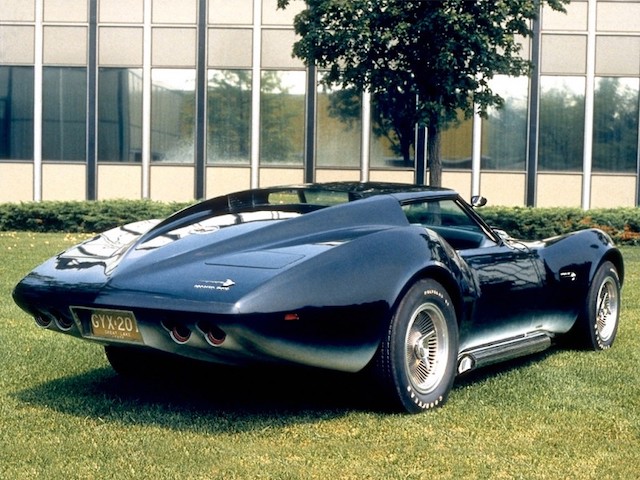
(GM)
The 1969 Corvette Manta Ray photographed at GM Styling in Warren, Michigan.
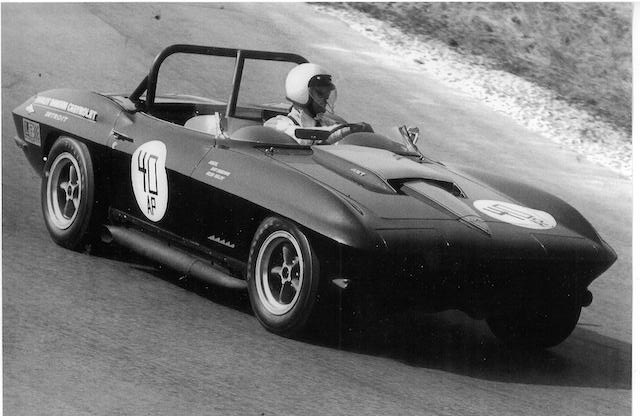
(The DeLorenzo Racing Archives)
Wilmot Hills, Wisconsin, May, 1967. Tony DeLorenzo’s first race in a Corvette – and first win in “A” Production – came at an SCCA Regional in Wilmot Hills, Wisconsin, in this brand-new 1967 L88 Corvette Sting Ray roadster sponsored by Hanley Dawson Chevrolet in Detroit. It was also the first time a 427 Cobra encountered the new L88 in an “A” Production race. This well-traveled Sting Ray is one of the most valuable Corvettes in the world not named “Grand Sport.”
The 1967 Corvette 427 L88 racing car. Tony began his racing career in something much more realistic and affordable than a Corvette, which turned out to be a ’65 Corvair. We started out pounding around at our local track here in Michigan – Waterford Hills – and from there it was on to Nelson Ledges, Ohio, and Mid-Ohio; a one-time event at an airport in Grayling, Michigan; Lime Rock Park, Vineland (New Jersey); and on and on. Two years later Tony talked Hanley Dawson, who owned Hanley Dawson Chevrolet in Detroit at the time, into sponsoring a Corvette in SCCA Racing. And after he agreed to do that, we ordered one of 20 L88 Corvettes made in 1967, in Black, of course (it actually turned out to be the first one built that year). I’ll never forget going down to the dealership after it arrived and taking it around the block. The thing was a monster in every sense of the word, and the sound that L88 made was spiritual. The first weekend we had it we installed a roll bar, replaced the stock exhaust system with a set of “OK Kustom” headers (from Flint), added a set of “Torq-Thrust” American Racing wheels, a set of Firestone racing tires, and we removed the windshield, cut the windshield posts down and put a plexiglass windscreen on. The debut race – and win – for Tony and that famous L88 Corvette came six weeks later in an SCCA Regional race at an obscure road race track in Wilmot Hills, Wisconsin. He went on to qualify for the SCCA Runoffs with that car, and then it eventually disappeared. It surfaced again, and after Tony documented its authenticity, it was restored back to its street configuration; then it was returned to its racing configuration – with Tony driving it in the Monterey Historics – then back again to its street configuration. This has become one of the most valuable L88 Corvettes in existence, and I think the last time it changed hands was for just under $2 million.
The 1969 Corvette “Daytona GT” L88 convertible. After the Owens/Corning Fiberglas sponsorship came to fruition (read “The Glory Days” series here -WG), we had the idea of building a limited-run of street Corvettes that would be branded as “Corvette Daytona GTs.” We build a prototype, which was based on a Black/Black (of course) Corvette convertible powered by a 427 L88 and equipped with our competition headers and side pipes, our FIA-specific Plexiglas covered front headlights, American “Torq-Thrust” wheels and racing tires. We even displayed it at the Detroit Auto Show at Cobo Hall that year. From the “Best Laid Plans” File, the demands of our burgeoning – and successful – racing effort overwhelmed everything else, and the Daytona GT idea fell by the wayside. But that wasn’t exactly the end of the story. The car was stored at my parent’s house, and I was tasked with keeping it in running condition, which I performed with relish. Needless to say, a Black/Black L88 Corvette with open side pipes caused quite a stir on Woodward and the surrounding environs. It was the quintessential Bad Ass machine. What happened to it? A Lufthansa Airlines co-pilot befriended Tony at Daytona, and he eventually asked if he would consider selling him a OCF-prepared Corvette. A deal was reached, and the Daytona GT was converted to OCF Corvette Racing specs. But not before Randy Wittine, the brilliant GM designer who created all of our iconic racing team liveries back then, came up with a wild “psychedelic” paint job for it that was drop-dead gorgeous. (Pictures exist somewhere, but they haven’t turned up.) Tony and I dropped it off at Detroit’s Metro airport, and watched it being loaded on to a Lufthansa freighter. That pilot proceeded to terrorize the equivalent of German SCCA national racing with that monster, humbling the usual assortment of Porsche 911s in the process. The car ended up back in the states somehow and is now used for vintage racing. Another Corvette life well-lived.
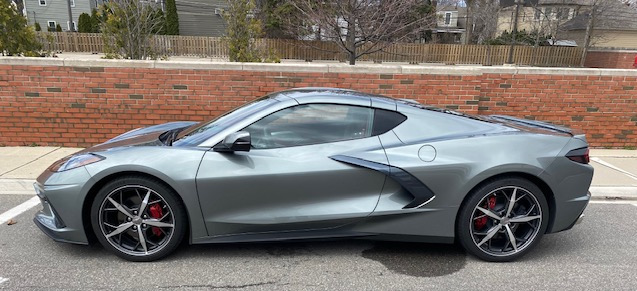
The 2022 Corvette Stingray Coupe. I am trying out a 2022 Corvette Stingray Coupe over the next few days, and I will have a report on it in our “On The Table” column next week. The well-optioned machine looks fantastic in its Hypersonic Gray Metallic and its “Morello Red Dipped” interior. And so, a new chapter begins…
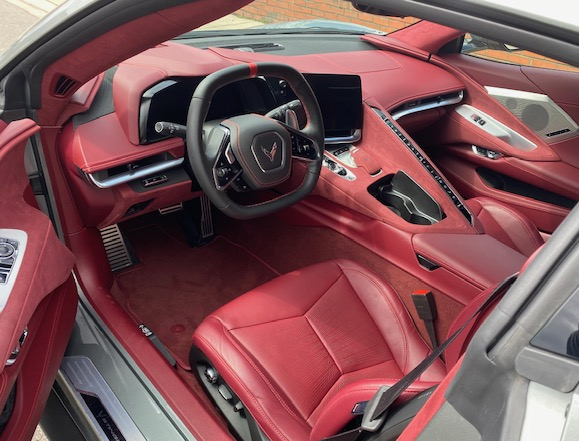
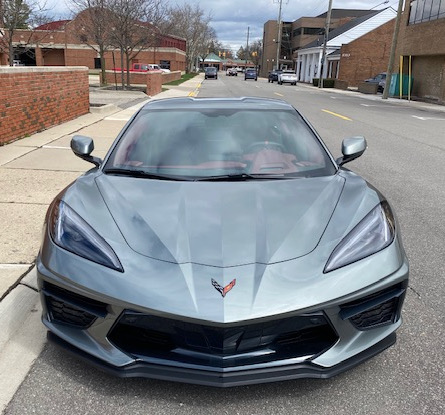
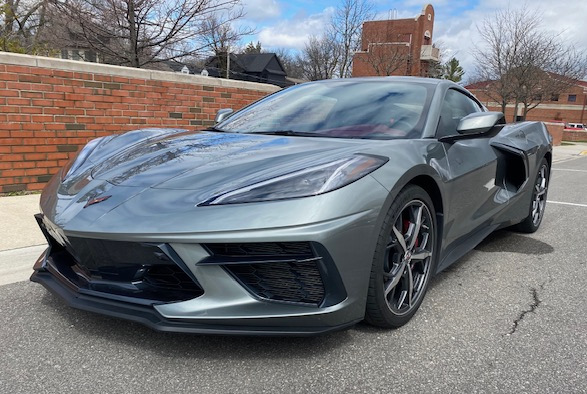
And that’s the High-Octane Truth for this week.
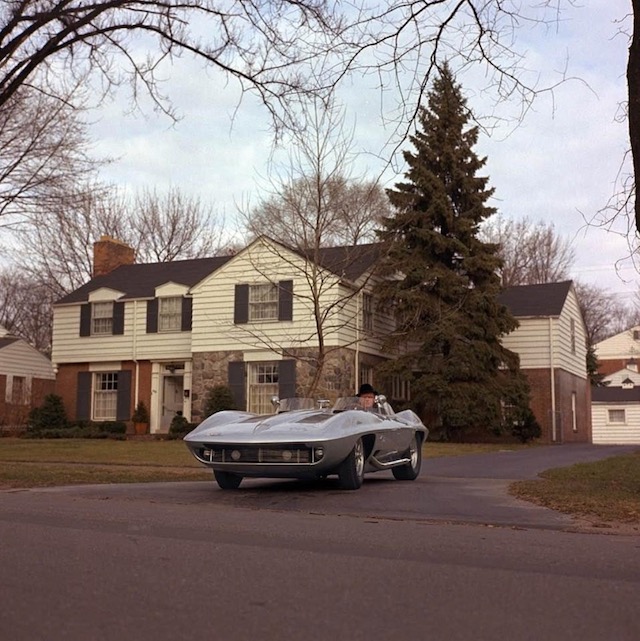
(GM Styling)
Bill Mitchell pulling out of his driveway on Bradway Boulevard in Bloomfield Village, Michigan, in the 1959 Corvette Sting Ray racer. He drove his favorite cars all the time.





More Stories
2022 Ford Bronco Raptor Unsurprisingly Thirsty at 15 MPG Combined
How to fix your sagging headliner
The Best 90’s Cars You Can Buy Today